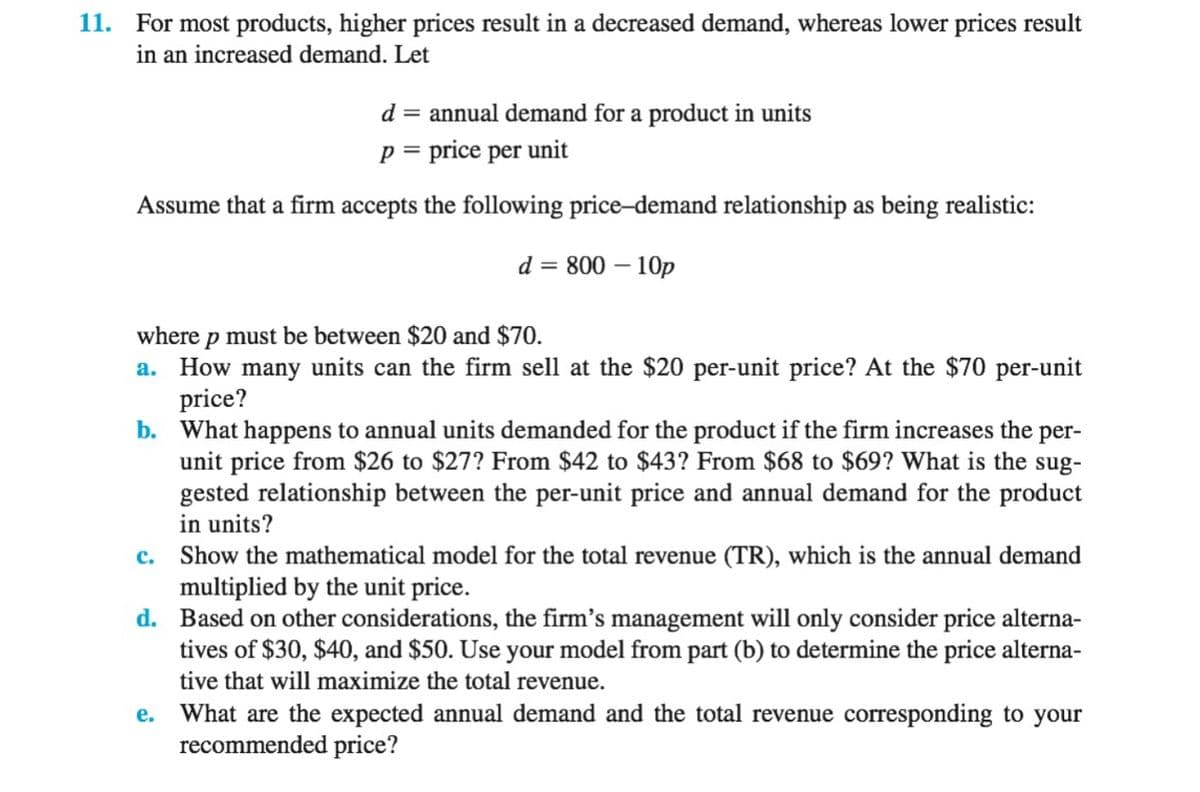For most products, higher prices result in a decreased demand, whereas lower prices result in an increased demand. Let d = annual demand for a product in units p = price per unit Assume that a firm accepts the following price-demand relationship as being realistic: d = 800 – 10p where p must be between $20 and $70. a. How many units can the firm sell at the $20 per-unit price? At the $70 per-unit price? b. What happens to annual units demanded for the product if the firm increases the per- unit price from $26 to $27? From $42 to $43? From $68 to $69? What is the sug-
For most products, higher prices result in a decreased demand, whereas lower prices result in an increased demand. Let d = annual demand for a product in units p = price per unit Assume that a firm accepts the following price-demand relationship as being realistic: d = 800 – 10p where p must be between $20 and $70. a. How many units can the firm sell at the $20 per-unit price? At the $70 per-unit price? b. What happens to annual units demanded for the product if the firm increases the per- unit price from $26 to $27? From $42 to $43? From $68 to $69? What is the sug-
Chapter17: Capital And Time
Section: Chapter Questions
Problem 17.10P: Wonopoly and natural resource prices Suppose that a firm is the sole owner of a stock of a natural...
Related questions
Question

Transcribed Image Text:11. For most products, higher prices result in a decreased demand, whereas lower prices result
in an increased demand. Let
d = annual demand for a product in units
p = price per unit
Assume that a firm accepts the following price-demand relationship as being realistic:
d = 800 – 10p
where p must be between $20 and $70.
a. How many units can the firm sell at the $20 per-unit price? At the $70 per-unit
price?
b. What happens to annual units demanded for the product if the firm increases the per-
unit price from $26 to $27? From $42 to $43? From $68 to $69? What is the sug-
gested relationship between the per-unit price and annual demand for the product
in units?
c. Show the mathematical model for the total revenue (TR), which is the annual demand
multiplied by the unit price.
d. Based on other considerations, the firm's management will only consider price alterna-
tives of $30, $40, and $50. Use your model from part (b) to determine the price alterna-
tive that will maximize the total revenue.
e. What are the expected annual demand and the total revenue corresponding to your
recommended price?
Expert Solution
This question has been solved!
Explore an expertly crafted, step-by-step solution for a thorough understanding of key concepts.
This is a popular solution!
Trending now
This is a popular solution!
Step by step
Solved in 2 steps

Knowledge Booster
Learn more about
Need a deep-dive on the concept behind this application? Look no further. Learn more about this topic, economics and related others by exploring similar questions and additional content below.Recommended textbooks for you

